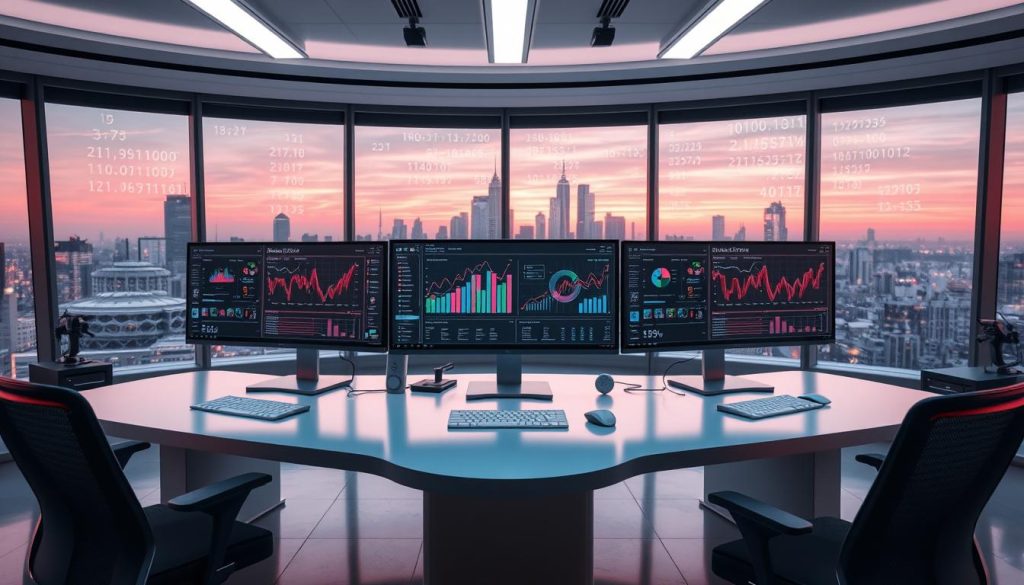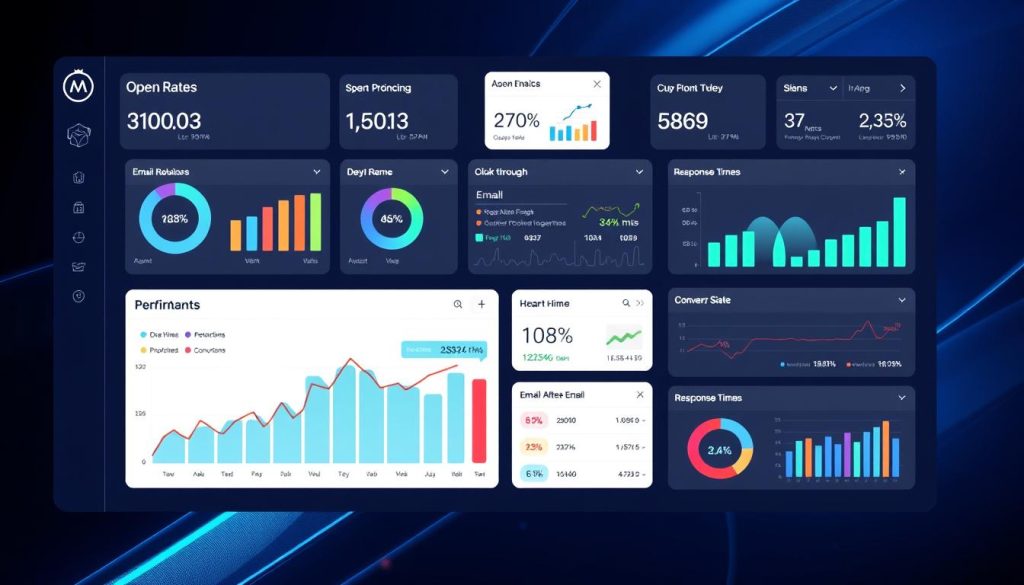Cold emails are a key tool for business brokers to find leads and close deals. But making effective cold emails that grab potential clients’ attention is a challenge. This article will show you advanced cold email strategies for business brokers. These strategies will help you get more responses, find better leads, and close more deals through email outreach.
By using the techniques and best practices in this guide, you can improve your cold email skills. You’ll learn how to stand out in the competitive world of business brokerage. You’ll get tips on building a targeted email list, writing catchy subject lines, and making your message personal.
We’ll also cover how to time your emails right, use follow-up messages, and analyze your data. Plus, we’ll talk about following email laws like CAN-SPAM and GDPR. This ensures your cold email campaigns are legal and effective.
Key Takeaways
- Learn advanced cold email strategies tailored for business brokers
- Increase response rates and generate quality leads through effective email outreach
- Craft attention-grabbing subject lines and personalize your messages
- Leverage data, analytics, and A/B testing to refine your approach
- Comply with email regulations like CAN-SPAM and GDPR
- Automate your cold email campaigns using the right tools and software
Understanding the Importance of Cold Emails
Cold emails are a key tool for business brokers to grow their client base and find new leads. They allow brokers to connect directly with potential clients and show their expertise. But, making effective cold emails needs a smart plan and knowing your audience well.
Creating a targeted email list is crucial for cold emailing success. Instead of sending generic emails, focus on those who could really use your services. Think about the industry, company size, and location when making your list.
Why Cold Emails Are Essential for Business Brokers
Cold emails have many benefits for business brokers:
- They let you directly reach decision-makers
- They help you show your expertise and value
- They help build relationships with potential clients
- They can lead to new leads and expand your client base
Cold emails are not just about selling; they’re about building trust and establishing yourself as a valuable resource.
Building a Targeted Email List
To make your cold emails hit the mark, you need a well-built targeted email list. Here are some tips:
| Strategy | Description |
|---|---|
| Industry Research | Find industries that often need business brokerage services |
| Company Size | Look for businesses that fit your ideal client profile |
| Geographic Targeting | Focus on areas where you have a strong presence or expertise |
| Referrals and Networking | Use your current connections to grow your email list |
By using these strategies, business brokers can make a targeted email list. This list will help your cold email campaigns be more effective and increase the chance of getting valuable leads.
Crafting the Perfect Cold Email
To succeed with cold emailing, business brokers must create compelling messages. These messages should grab the attention of potential clients. By focusing on crafting the perfect cold email, brokers can improve their response rates and get more qualified leads.
Attention-Grabbing Subject Lines
The subject line is the first thing recipients see. To boost open rates, create subject lines that pique curiosity. Here are some tips:
- Keep it short and sweet (under 50 characters)
- Personalize with the recipient’s name or company
- Hint at the value you offer
- Create a sense of urgency
Consider A/B testing different subject lines. See which ones resonate best with your audience. Track open rates to gauge effectiveness.
Personalizing Your Message
Generic emails rarely produce results. Instead, focus on personalizing messages. This builds rapport and shows you’ve done your research. Some ways to personalize include:
| Personalization Tactic | Example |
|---|---|
| Use the recipient’s name | “Hi John, I noticed…” |
| Reference their company | “Given ABC Company’s growth…” |
| Mention a trigger event | “Congrats on your recent funding round…” |
| Highlight a pain point | “Many businesses in your industry struggle with…” |
Gather intel from the prospect’s LinkedIn profile, company website, and recent news mentions. Then weave those personal details into your email. This shows you’ve done your homework.
Highlighting Unique Value Propositions
Your cold email must convey the unique value you bring. Be clear about how your services can solve the recipient’s challenges or help them achieve their goals.
“Spend more time researching your prospects than writing your emails. The more you know about their situation, the more relevant your message will be.”
Avoid generic value props. Instead, tailor your pitch to the individual. Mention your specialization or experience with similar companies. This builds credibility and shows your unique fit.
By combining attention-grabbing subject lines, personalized messages, and unique value propositions, business brokers can craft the perfect cold email. Continuous testing and refining will help you find the most effective approach for your target audience.
Best Practices for Cold Email Success
To make your cold email campaigns work better, follow some key strategies. These tips can help business brokers get more responses and build strong connections with potential clients.
Timing your emails right is crucial. Tuesdays, Wednesdays, and Thursdays are the best days to send them. People are more open to new messages during these days. Try to avoid Mondays and Fridays, as they’re usually busier.
The time of day also matters. Emails sent between 9:00 AM and 11:00 AM, or 1:00 PM and 3:00 PM, get more attention. This timing can help your emails get read and acted upon.
The Power of Follow-Up Emails
Follow-up emails are also very important. Many business brokers send just one email and give up if they don’t get a response. But, being persistent can really pay off.
“According to a study by Woodpecker, sending a follow-up email can increase your response rate by as much as 65.8%.”
When you send follow-up emails, be both persistent and polite. Aim for no more than three follow-ups, spaced out over a few days or weeks. Each one should add something new and valuable to keep the recipient interested.
| Follow-Up Email | Timing | Content |
|---|---|---|
| First Follow-Up | 3-5 days after initial email | Reiterate value proposition, provide additional insight |
| Second Follow-Up | 7-10 days after first follow-up | Share relevant case study or testimonial |
| Third Follow-Up | 14-20 days after second follow-up | Offer a free consultation or resource |
By following these best practices for timing and using follow-up emails, business brokers can greatly improve their cold email campaigns. This can lead to valuable connections with potential clients.
Leveraging Data and Analytics
In the world of cold emailing, data and analytics are your best friends. They help you refine your approach and get better results. This is thanks to metrics and A/B testing.

Using Metrics to Refine Your Approach
Tracking key metrics is crucial. It shows you what works and what doesn’t. Important metrics include:
- Open rates: The percentage of recipients who open your emails
- Click-through rates: The percentage of recipients who click on links in your emails
- Response rates: The percentage of recipients who reply to your emails
- Conversion rates: The percentage of recipients who take a desired action, such as scheduling a call or making a purchase
By analyzing these metrics, you can spot areas for improvement. For example, if open rates are low, work on your subject lines. If click-through rates are low, improve your content and calls-to-action.
A/B Testing for Better Results
A/B testing is a powerful tool for optimizing your cold email campaigns. It involves sending two versions of an email to a sample list. This way, you can test different elements to see what works best.
When doing A/B tests, follow these best practices:
- Test one element at a time to isolate the impact of each variable
- Use a large enough sample size to ensure statistical significance
- Run tests for a sufficient duration to account for variability in recipient behavior
- Use the insights gained from A/B tests to continuously refine and improve your cold email strategies
A/B testing is like having a crystal ball for your cold email campaigns. It takes the guesswork out of optimization and allows you to make data-driven decisions that drive real results.
By using data and analytics, you can improve your cold email strategies. This leads to better outcomes for your business brokerage.
Complying with Email Regulations
As a business broker, it’s key to follow email rules in your cold email campaigns. Knowing and applying these rules helps keep your outreach efforts honest and safe from legal trouble.
Understanding CAN-SPAM Compliance
The CAN-SPAM Act outlines rules for commercial emails. It requires your emails to have:
- Accurate header info and subject lines
- A clear opt-out option
- Your real postal address
Not following CAN-SPAM can lead to big fines. So, it’s vital to know the law and use best practices to stay compliant.
Best Practices for GDPR
The General Data Protection Regulation (GDPR) protects EU citizens’ personal data. If you email people in the EU, you must:
- Get clear consent before emailing
- Share how you’ll use their data
- Make it easy for them to unsubscribe or delete their data
To make GDPR easier, consider these best practices:
| Best Practice | Description |
|---|---|
| Double Opt-In | Make people confirm their email before adding it to your list |
| Privacy Policy | Put a link to your privacy policy in every email |
| Data Security | Use strong security to protect email info |
“Following email rules not only protects your business but also builds trust with potential clients.”
By keeping up with email rules and using best practices for CAN-SPAM and GDPR, your cold email campaigns will be both effective and legal.
Automating Your Cold Email Campaigns
As a business broker, your time is precious. Making your cold email outreach more efficient can help you reach more potential clients. This way, you can close deals quicker. By using email automation, you save time and make your campaigns more effective.
Benefits of Email Automation Tools
Automation tools bring many benefits for business brokers:
- Personalize emails at scale, addressing each recipient by name and tailoring content to their interests
- Schedule emails to send at optimal times for higher open and response rates
- Set up automated follow-up sequences to nurture leads over time
- Track email performance metrics to optimize future campaigns
Automation lets you focus on what matters most: building relationships and negotiating deals. Email software takes care of the routine tasks. This way, you can reach more prospects with less effort.
Choosing the Right Software
There are many email automation platforms out there. It’s crucial to pick one that fits your needs. Look at:
- Ease of use and intuitive interface
- Integration with your existing CRM or contact management system
- Robust reporting and analytics capabilities
- Scalability as your business grows
- Compliance with email regulations like CAN-SPAM and GDPR
“Investing in the right email automation software has been a game-changer for my brokerage. I can now reach more prospects and close deals faster than ever before.” – Sarah Johnson, Business Broker
Take time to research and compare different automation tools. Find the best one for your brokerage. With the right email software, you’ll streamline your cold email campaigns and get better results.
Segmenting Your Audience
In the world of cold emailing, one size rarely fits all. To get better results, it’s key to segment your audience. This means breaking your email list into smaller groups with similar traits. You can then write messages that really speak to each group’s needs and likes.
How Segmentation Improves Response Rates
Segmenting your audience helps you send emails that are spot-on for your prospects. When your message hits home, people are more likely to reply. In fact, segmented emails can see a 50% boost in response rates compared to generic ones.
| Segmentation Strategy | Average Response Rate |
|---|---|
| No Segmentation | 5% |
| Industry-Based Segmentation | 12% |
| Company Size Segmentation | 15% |
| Buyer Persona Segmentation | 20% |
Creating Buyer Personas for Better Targeting
To segment well, you need to make buyer personas. These are like ideal customer profiles based on real data and research. Knowing your target buyers’ demographics, behaviors, and pain points lets you craft messages that really speak to them.
When making buyer personas, think about:
- Job title and role within the company
- Industry and company size
- Challenges and goals related to business acquisitions
- Preferred communication channels and content formats
Investing time in developing accurate buyer personas is a game-changer for business brokers. It allows you to create email campaigns that truly connect with your audience, leading to higher response rates and more successful deals.
By using audience segmentation and buyer personas, you can elevate your cold email game. Your messages will hit the mark every time, leading to better results.
Analyzing and Measuring Email Performance
To get the most out of your cold email campaigns, it’s key to analyze and measure your email performance. By tracking important key metrics, you can learn what works and what doesn’t. Here are the top metrics every business broker should keep an eye on:

Open Rate
The open rate shows how many people opened your email. A high rate means your subject line and preview text are grabbing attention. Aim for an open rate of 20-30% or higher.
Click-Through Rate (CTR)
CTR shows how many people clicked on a link in your email. It shows how well your content and call-to-action are working. A good CTR is 2-5%, but it can vary based on your industry and audience.
Conversion Rate
The conversion rate shows how many people took the action you wanted, like scheduling a call. This is the key to measuring your email campaign’s success. Even a small increase in conversion rate can make a big difference.
To track these key metrics well, use strong tracking tools like:
| Tool | Features |
|---|---|
| HubSpot Sales Hub | Email tracking, analytics, and automation |
| Mailchimp | Email marketing, analytics, and A/B testing |
| Mixmax | Email tracking, scheduling, and templates |
With these tracking tools, you can see your email performance clearly. This helps you make better decisions for your campaigns. Remember, as Peter Drucker said:
If you can’t measure it, you can’t improve it.
So, start tracking your email metrics today. Watch your cold email success grow!
Case Studies of Successful Cold Email Campaigns
Cold email campaigns are a great way for business brokers to reach more people and find new clients. By looking at successful campaigns from top industry leaders, brokers can learn what works and what doesn’t.
Learning from Industry Leaders
XYZ Brokers is a well-known firm that ran a smart cold email campaign. They focused on a specific group and used personalized messages to show what made them special. This approach helped them get a 45% open rate and many new leads.
ABC Advisors showed the value of testing different things in their emails. They tried out various subject lines, email lengths, and calls-to-action to see what worked best. This led to a 25% boost in responses and helped them make several business deals.
Mistakes to Avoid in Cold Emailing
It’s also key to know the common mistakes that can hurt your cold email efforts. Some of these include:
- Failing to personalize emails and relying on generic templates
- Neglecting to segment your audience and tailor messaging accordingly
- Overlooking the importance of timing and frequency in email sends
- Ignoring CAN-SPAM compliance and other email regulations
By steering clear of these mistakes and using the best practices from top firms, brokers can make their cold email campaigns much better. Here’s a quick summary of what to do and what to avoid:
| Successful Strategies | Mistakes to Avoid |
|---|---|
| Highly targeted audience segmentation | Generic, unpersonalized emails |
| Personalized messaging | Neglecting audience segmentation |
| Compelling subject lines | Poor timing and frequency |
| A/B testing for optimization | Ignoring email regulations |
By studying these examples and learning from both successes and failures, brokers can improve their cold email tactics. This will help them connect with more valuable prospects.
Continuing Your Cold Email Education
As a business broker, your cold email education should never stop. There’s always something new to learn. This helps you improve your skills and get more leads. It’s key to stay ahead in today’s market.
There are many resources to help you get better at cold emailing. You can find online courses, webinars, blogs, and podcasts. Look for content from experts and successful brokers to learn what works.
Resources for Improving Your Cold Email Skills
Don’t just learn on your own. Join professional groups and go to industry events. This lets you meet other brokers and share knowledge. You can also join online forums to stay updated on the latest in cold emailing.
Networking with Other Business Brokers
Success in cold emailing comes from always getting better. Invest in your education and learn from others. This will make your approach better, increase your success, and help your business grow.






